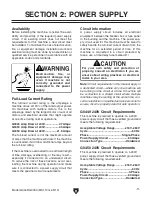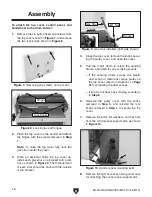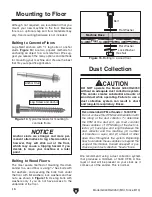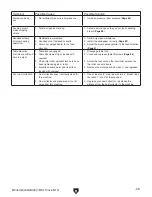
-24-
Model G0449/G0450 (Mfd. Since 8/13)
Operation Overview
A typical workpiece is sanded by turning the
sanding drum and conveyor motors
ON.
While standing to the side of the sander, the
operator places the workpiece on the conveyor
belt. As the workpiece moves forward on the con-
veyor, the front pressure rollers press down on
the top surface of the workpiece. The workpiece
moves forward, passing under the front and rear
sanding drums, which remove material from the
workpiece surface. A pressure roller behind each
sanding drum exerts downward pressure on the
workpiece, thereby minimizing the possibility of
the workpiece slipping and kicking back at the
operator. The operator receives the workpiece at
the rear of the sander.
Since the sanding drums only remove a small
amount of material, the workpiece is usually
passed through the sander, then turned 180° to
ensure an even cut. This is repeated to yield the
desired result.
The operator rotates the table height handwheel
to control the cutting depth. If the handwheel is
rotated
3
⁄
4
turn, approximately
1
⁄
64
" of the workpiece
will be removed by the sanding drums.
Typically the operator installs a coarser grit sand-
paper on the front drum and a finer grit sandpaper
on the rear drum, then uses combinations of pro-
gressively higher grit numbers.
A variable speed knob allows the operator to
adjust the conveyor speed for the specific type of
workpiece and finish stage.
Additional Controls
Table Height Handwheel: Manually raises or
lowers the conveyor table. One full turn of the
handwheel changes the height of the table 0.020."
Depth Scale: Indicates the thickness the
workpiece will be after it has been sanded.
Figure 23. Additional front controls.
Emergency Stop Bar
Table Height
Handwheel
Variable Speed
Control
Emergency Stop Bar: Stops electricity to the
motors to stop the sander immediately.
Variable Feed Rate Dial: Adjusts the feed rate
between 6 and 18 FPM.
Depth
Scale
Summary of Contents for G0449
Page 80: ......
















































